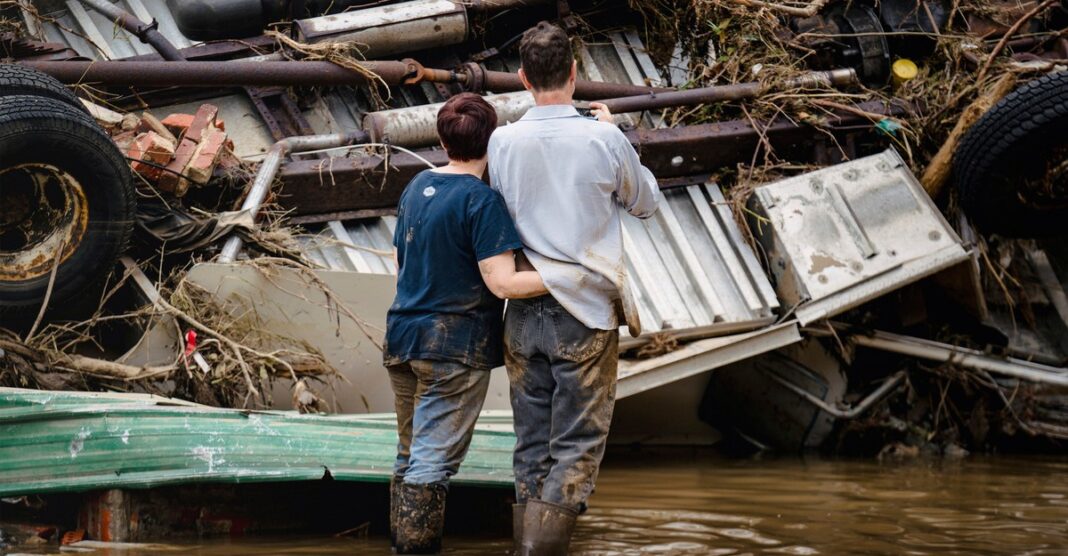The last text message I received on Friday morning from Josh, a close friend since kindergarten, read: “I just had to wade in waist deep water to rescue my dog. Everything I own is ruined. I’m a bit emotional. Sorry. I need a min.”
Cell service dropped. Wi-Fi signal disappeared.
Josh lives 12 minutes from my house, which is near Cherokee, North Carolina. That short stretch of land and water between us made all the difference this week. Scotts Creek, which runs right by Josh’s house and is usually benign enough, swelled and formed a deadly confluence with the Tuckasegee River. And Dillsboro, his tiny community, just a few blocks in total, was submerged beneath the flood waters Hurricane Helene had induced.
I was on the mountain, and my friend was in the valley.
I’d promised myself I would never be here again—caught in a 100, maybe 1,000-year flood. This time, I was far from my eastern Kentucky friends and their scarred banks, still mending from the devastating flood of 2022. These western North Carolina highlands, largely protected from extensive mining extraction for millennia, would protect me and the others who call them home.
And from my front porch, these mountains of my home did hold. These river banks were true. These creeks culled most swells. They kept my promise. My front yard today does not look like the ones I drove past in 2022 as I fled Hindman, Kentucky, a hazy dawn lighting my way on that late-July morning.
What I can’t quite reckon with is that my neighbors’ yards do. Twelve minutes down the road. An hour east, in Asheville. Or just a bit farther, in Boone and most of the communities in between. Sporadic pictures filtering through spotty Wi-Fi service look remarkably similar to the calls for help from two years ago in the Bluegrass State. Death tolls climb. Even in Cherokee, people are making runs on gas. Boil-water advisories are in effect regionally. Friends can’t locate family.
My promise might have helped quell my fears. But promises are premised on what has come before, on what seems reasonable and possible. In Cherokee, we have become accustomed to hearing the phrase for over 10,000 years, in commercials and museum exhibits explaining to tourists how long we, Cherokee people, have existed in our homelands. How many 100-year floods and 1,000-year floods has this land seen in that time? Whatever math governs that past does not hold in this new era, in which I can live more than 40 years without experiencing a natural disaster, and then live through two cataclysmic floods within two years.
On the morning of Thursday, September 26, 2024, I was in Asheville, and the rain had already begun. I learned from my Kentucky experience that I needed to have groceries at home, and water, maps, rubber boots, and a full gas tank in my car. I also knew that I should stop by Biltmore Village to pick up my son’s suit for his high-school homecoming. Yes, I was still imagining that he could escort his friend onto the football field in a few days, maybe even attend the dance. Even as I prepared for a flood, I was sure that I would not have to survive another one.
Biltmore Village is notorious for flooding even under mild rainy conditions, and when I arrived, part of the shopping area was already blocked off. I waited for the store to open; the rain continued to steadily fall. I watched a video on my phone, supposedly from the previous evening, of a car attempting to drive through floodwater just beyond the barricade I could see from my back window. I checked the weather maps again. I decided that my son wasn’t going to need a suit anytime soon.
I drove home thinking about how most people in western North Carolina had not seen the mattresses hanging from trees or known the people stranded on the other side of a creek by a washed-out bridge, as I had two summers ago. They hadn’t smelled the gasoline in the air and watched boats float down KY 160. I drove home unsettled by the thought that I would soon be comparing catastrophic flood experiences.
I texted Josh and told him that he should leave—come stay with me. Bring his dog. I knew the Scotts Creek he saw from his porch in Dillsboro might be calm still, but I also knew how troublesome a creek can become. He assured me that he wasn’t worried.
As I drove, I held on to the promise of these mountains. That, unlike many in eastern Kentucky, they had not been lopped off for strip-mining by coal companies, the lack of vegetation allowing walls of water to cascade down them unrestricted; they did not contain coal-slurry ponds teetering on the brink of collapse, spilling into the hollers below. Yet, in my rearview on Interstate 40 and Route 74, I could see summer homes wedged into mountain slopes like Jenga pieces and far more economically fashioned homes dotting would-be floodplains. Creeks here don’t rise like that, I assured myself. They don’t wipe out western North Carolina communities. In the back of my mind was an image of Canton, North Carolina, underwater in 2021. Rare. Isolated.
When the rain became mist and the world grayed into silence the day after losing all communication, I ventured out to check on Josh. He was cleaning his apartment, running dehumidifiers and thanking friends who offered help. He was safe. His dog was safe. He pointed to a group of adults and children washing down the street with hoses and brooms. The children were covered in mud and barefoot. “They’re a church group,” he explained.
I thought back to the pickup truck that had pulled up to the house we were mucking out in Bulan, Kentucky after their disaster. The man who hopped off the back was the son of the mayor of the next town over and offered us all tetanus shots to stave off the effects of hazardous waste in the flood waters. I wondered if these church kids had had their shots—if their parents knew they might need one.
As I write this, I don’t know how all the cities and towns of western North Carolina are faring. I know that gas is scarce, and still none of us have reliable cellular or Wi-Fi service. I know that the Dollar General is out of eggs. I know that rockslides cover some roads and many others have crumbled. I know that the hospital in Cherokee cannot send patients to Asheville’s Mission Hospital for critical care. I know that homes are gone and lives are gone. I know that my 11-year-old remarked on how “the people who lived under the bridge have nowhere to go now,” because the waters washed away their encampments.
And I know that, through all the rain and rise and wind, the roadside campaign signs survived, symbols of other promises. Promises that we can curb the tides of global warming. Promises that global warming doesn’t exist. Promises that Appalachia is not forgotten. And I remember that promises don’t do much, and rarely hold. They might help quell our fears, but these promise-makers, too, don’t know what they don’t know. Promises are facades of safety that we make for ourselves, and that politicians often make for us, in place of protective action.
After the waters recede and connectivity returns, what is certain, what I know we can count on, is the tenacity of Appalachia. Faster than the flood waters rose, the people of Kentucky began organizing for North Carolina. They began reaching out, checking in. I can almost feel them at the borders, pickup trucks loaded, hearts full. A week ago, they probably put out their own campaign signs. Some red. Some blue. Yet they all recognize the white sign of surrender to Mother Nature, arriving to help long before promises from politicians have time to break.
The thing is, Appalachia rarely fails to remember the small towns like Dillsboro. We’re a holler people, loyal to our mountain valleys, not afraid to stretch a helping hand beyond the city centers. And that’s what it will take here. Metro areas like Asheville need an enormous amount of support, but so do our more remote Appalachian communities. And if another flood comes, the people in these towns will care for the next. This fierce allegiance can only go so far; I fear that the world’s choices are once again heralding disastrous consequences for the mountains we have protected for 10,000 years. But I also wonder how people here and in all the places beyond can repair the damage we’ve done. I guess it depends on what we choose to see beyond our own high ground, our state borders, our reliance on someone else’s promise.
Every community has to decide its own values, its own priorities. But sometimes circumstances dictate them, and what promises we can keep. My son’s school still held its homecoming dance on the Saturday following the flood. He didn’t go. It’s possible his suit is still underwater.




